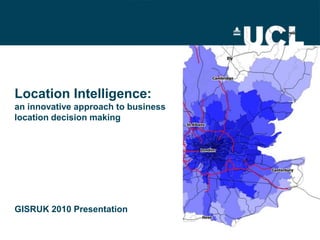
1A_1_Location Intelligence: an innovative approach to business location decision making
- 1. Location Intelligence: an innovative approach to business location decision makingGISRUK 2010 Presentation
- 2. One in seven jobs in London can be directly attributed to FDI – a total of 516,000 jobs, or a quarter of London’s economy (LDA 2004) Research sponsored by Think London (LDA, GLA) official foreign direct investment agency for London. connects international businesses to London, helping them set up, succeed and grow. Foreign Direct Investment in London
- 3. London’s FDI promotion needs Need for a toolset to guide and inform investors on suitable locations in London: Based on investors individual needs and demands. Using a consistent, quantifiable methodology. Need for a better understanding of London’s diverse business neighbourhoods: To formalise and highlight London’s subregional offer to investors Need to record and analyse client’s decision making processes: To gain better understanding of spatial decision making processes. Develop location intelligence that can be fed back to stakeholders
- 4. Understand London’s polycentric business environments through the characterisation of London’s geo-business neighbourhoods (at an appropriate spatial scale), Formalise business location decision making, qualifying and quantifiying location preferences according to investor needs, Support business site decision making through integrated toolset.
- 5. Data BaseA geo-business neighbourhood classification
- 6. Town Centre Boundaries(Thurstain et al. 2001) Consistent boundaries for Town Centres across England and Wales. Define consistent & relevant set of boundaries for London neighbourhoods Based on quantifiable indicators Relevant to London’s economic landscape: (80% of London’s employment in & around TC) Relevant to stakeholders and decision makers Spatial Database aggregated by TC boundaries
- 8. Principal Components Reduce Spatial database (50 variables) to a smaller number of components Components characterise as completely as statistically achievable, both the common and unique variance of the original variables. Components describe different aspects of Town Centres aggregating positively and negatively correlated variables. Component scores quantify likeness of individual town centres Develop from components rich multifaceted profiles describing different business environments Relevant to investors
- 10. Keywords: Professional and financial service economy, mix of large & small employers, skilled managerial and professional employees, land use predominantly high quality offices, limited retail space, Urban professionals Most representative Cheapside Leadenhall Liverpool Street and Bishopsgate Holborn Canary Wharf Least representative Brent Cross Hendon Central Bexleyheath Chingford Mount Hornchurch
- 11. Keywords: Manufacturing, food and drink as well as distribution economy, mix of large and small employers, routine and technical employees, land use predominantly warehousing, limited office space Blue Collar Industry Most representative Dagenham Bow Kenton North Tottenham Lower Edmonton Least representative Norbury Eastcote Pinner Brent Street Hampton Wick
- 14. Model & User base:Prototype Implementation
- 17. feelings or emotionsCalculate the absolute priorities of the location variables of the hierarchy Apply weights to variables to determine most suitable locations
- 18. Prototype implementation Combining data base (geo-business classification) & MCDM (AHP methodology) into web application Demonstration of research Built as a lightweight web client Focus on rapid prototyping Scenario based user testing evaluating data & methodology: Consistency of decision making between FDI expert and non experts Relevance of resulting recommendations (Limited evaluation of usability of prototype)
- 22. Concluding remarks Consistency of results: Expert & Non Expert Users through system came to similar final weights given the same information Results overall were relevant: Prototype provided relevant location recommendations to users Effective tool to explore London’s diverse business neighbourhoods Opportunities for further research: How to limit complexity of AHP questionnaires (number of pair-wise comparisons) How to improve accessibility measures (transport data access)+ other data How to use past decisions to improve future recommendations
- 23. Thank you
- 24. London, a city of villages “There is no logic to London, it is a collection of villages slung chaotically together” (Wilson 1993) “London, more by fortune than design” (Hebbert 1998) “Greater London has come into existence as a construction of many individual towns and cities”(Hall and Thurstain-Goodwin, 2000) + Recent CASA work “Commuting in a polycentric city” (Roth et al 2010)
- 25. Spatial Database
- 26. Why a Spatial Decision Support Systemadapted from Geoffrion (1983), Densham & Goodchild (1989) Explicitly designed to solve ill- defined, ill structured and complex spatial decision problems powerful and easy to use interface combining (spatial) analytical models and data in a flexible manner (including geo-statistics & ESDA) represent complex spatial relations and structures help the user explore the solution space (the options/alternatives available to them) support a variety of decision-making styles problem solving is interactive and recursive
Notas do Editor
- Data Requirements were gathered from: Literature Review of Competitiveness Frameworks, Business GeographyCity Benchmarking Studies (qualitative & quantitative)Historical Review of London FDIInvestors, Think London staff & Stakeholder InterviewsNEED to simplify this database to allow presentation and evaluation by investors
- 64% of total variance of original dataset maintained in 9 Components
- Notes on further work : 1: As with AHP, number of pair-wise comparisons grows exponentially as number of locations variables (in a given hierarchical level/group) grows, need to find way to preselect variables of interest to decision maker2: In prototype system, only had access to limited accessibility data across London. Need for improved and complete public transport travel times data, and taking into account more individualistic accessibility requirements from individual decision makers3: Tool already records weights generated by each user of the system, how to incorporate that information to feedback intelligence not only to stakeholders, but also improve recommendations from system for future users